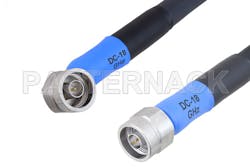Handheld Analyzers and Cable Testers Require Rugged RF Test Cables Part 2
In our last post, the potential benefits of rugged RF test cables for handheld analyzers and cable testers was discussed. In this post, we will focus more on the features of rugged RF test cables, and how they provide benefits for harsh environment and use applications. As was mentioned in the last blog, the main design features that enable rugged coaxial cable assemblies are UV-resistant jacketing, material construction allowing for wider operating temperatures, crush and torque resistant armor, corrosion resistant conductor plating, and mechanically sturdy and reliable stainless steel body construction.
The jacketing of an RF test cable assembly is actually very important in maintaining the electrical performance and mechanical protection of an RF cable. Exposure to UV radiation can often change the cable jacket’s mechanical and material properties, and if the cable jacket isn’t UV resistant, this could cause the cable to fall out of specification or otherwise lead to cable damage and failure. An example would be UV exposure causing the cable jacket to stiffen and eventually crack, which could reduce the cable’s phase stability during flexure and allow water and corrosive ingress into the cable and connector.
Equally as important as the jacketing, crush and torque resistant cable armor can prevent the occasional banging, crushing, or shock from causing the delicate internal coaxial cable structures from compressing, pinching, twisting, or otherwise deforming and damaging the cable. Though cable armor does increase the weight and diameter of a cable, it also can prevent excessive twisting and bending from damaging the cable, and aids with maintaining phase stability during flexure after repeated use. This can be especially useful during installation, as the forces placed on a coaxial cable while it is being pulled through metal structures, conduit, or other building structures can be significant. Cable armor also protects from punctures and gouges, which could easily end the life of a less rugged cable.
Material construction that enables environmental resilience, such as temperature and corrosive resistance, helps in prolonging cable life while used in harsh environments. Even while in storage, an RF test cable can be damaged by intense heat or cold, as the material properties of the plastic dielectrics and jacketing can be affected in extreme conditions. Though most RF test cables won’t experience the same environmental conditions as commercial airliners or jet fighters, for less environmentally resilient test cables, even short term exposure can damage a cable enough for it to be useless for prevision RF testing. Moreover, an environmentally resilient cable assembly design will ensure consistent and accurate testing over a longer lifespan than typical coaxial cable.
Another important factor with RF test cables for field applications, is to have a variety of RF coaxial connector options to choose from. Many technicians will carry several test cables and adapters, so that they can more readily use their portable analyzers with whatever connectors the installation uses. Using RF adapters at test equipment ports, and for cables that experience frequent mate/demate cycles, can help to ensure the test cables and test equipment ports are clean and in good condition. As test cables are typically cost more than adapters, this method is a convenient and cost effective approach to maintaining field test equipment.
Learn more about Pasternack’s line of Rugged and Phase Stable RF Analyzer Cable Assemblies:
